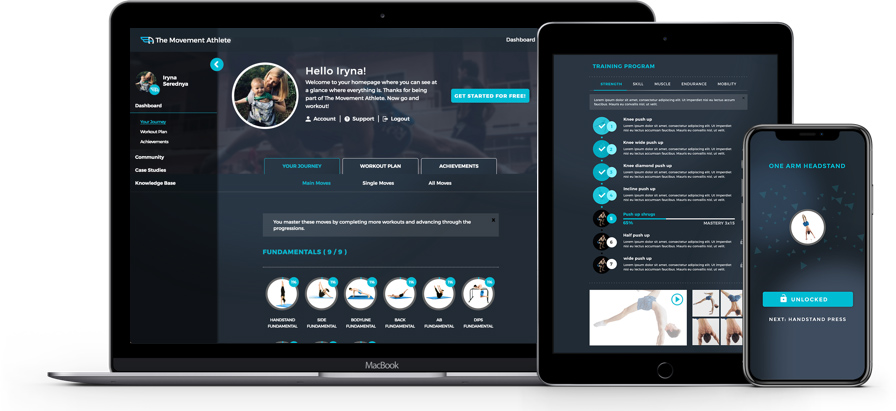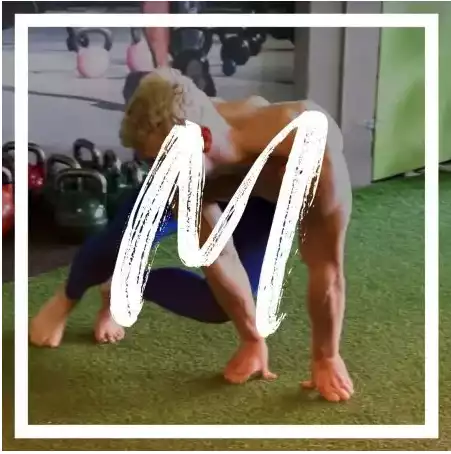A lot has been said about the (frankly weird) competition between weight training and bodyweight training.
“You take forever to build muscle,” says the first camp.
“You’re rigid and easy to tire,” says the other.
Others, such as the always great unmeasured fitness, are more balanced in their approach.
But while there is definite merit to both sides of the argument, there is no real reason for them to be as exclusive as they are.
Both weight training and calisthenics have their comparative advantages and disadvantages. Instead of choosing one and sticking with it religiously, why not combine the two and enjoy the best of both worlds?
Well, there are potential pitfalls on this path.
Overlap between muscle groups can happen if you’re not careful, which can easily lead to overtraining.
But if you apply everything in the proper dose, a good hybrid program will give you quick and thorough strength and muscle gain, along with incredible endurance, balance, and mobility.
Muscle Gain and the Hybrid Program
The idea behind muscle gain is simple, and follows three basic steps:
- Eat well. Because you can’t make something out of nothing, you will need to establish a caloric surplus in order to enjoy any gains. As a rule of thumb, protein is always good, as are the higher quality fats. No input equals no output.
- Work out. Now that raw materials are in the system, you will need to tell the system what to do with them. This is done by working out a muscle or muscle group. The higher the intensity of the workout, the greater the gains, but the muscles will then also need more time to recover. Which brings us to…
- Rest. This is when the progress happens. Force things, and you will in fact lose progress, because the muscles in question will not get the chance to grow. For anything other than rapid, extreme weight loss, overtraining is always bad.
By now you should probably see both the upside and the potential downside of a hybrid weight and calisthenics program. Upping the intensity is easy, but at the risk of going overboard and gimping yourself in the long run. This however, is easily rectified by tailoring a program that does not allow for any overlap.
The Core of the Program: Different Muscles and How to Work Them
So what you want to do is pick an exercise for each body part you that want to improve on. Most people tend to work out their whole body, but we will assume that you know your goals.
If strength is what you aim for, you will want to use weights on that body part. If you want fine tuning, definition, or endurance, you will use calisthenics.
If your goal is hypertrophy (listed below), you should use both, but will not work on that part of the body more than once a week, twice at most.
What follows is a list of exercises, weight and bodyweight, organized around body parts. You can’t really go wrong with any of them, but experimentation is encouraged, as is a proper warm-up before each workout session. Better safe than sorry.
Chest Exercises
Calisthenics
Push-ups
Dips
The Planche (or any of its progressions)
Back Exercises
Calisthenics
Push-ups
Dips
The Planche (or any of its progressions)
Arms (Biceps)
Calisthenics
Arms (Triceps)
Calisthenics
Shoulders
Calisthenics
Handstands (and its progressions)
Handstand Push-ups
Crow Pose
Legs
As said above, all of these are good, and you are free (and encouraged) to mix and match in order to figure out what works for you. Be persistent, don’t overlap too much, and you are going to see results far beyond what you are used to with either weight training or calisthenics alone. If however your goal is to get big, then we suggest a slightly different approach.
If the above program is too basic for your needs, feel free to check out the programs below. They focus mostly on calisthenics, but can easily be mixed with weight training programs.
- Facebook Group
- 1000+ Videos
- Mobile Progression Based App
- Online Portal
- Personalized workouts based on initial assessment
- Mobile and Desktop
- Facebook group
- A lot of encouragement to talk to coaches
- PDFs (schedules)
- Excel Files (Evaluations)
- Online Portal / Dashboard
- Videos
- Mobile and Desktop- Desktop preferred
- Add-on subjects: Nutrition, Mobility, Regeneration, Amongst Others
- Facebook Group
- Bodyweight, Kettlebell, and Dumbbell Options Available
- Videos
- Online Portal
- Mobile and desktop
- Supporting Content on Breathwork, Motivation, Warm-ups, and More!
- Facebook Group
- Sub-reddit - Extra paid "family" community
- 17 Core Classes + Extras
- Hundreds of Videos
- Online Portal
- Desktop preferred
- Supporting Content on Nutrition, Motivation, and More
- Facebook group
- Bodyweight 1.0 workout program
- Bodyweight 2.0 workout program
- Kettlebell 10-weeks
- 30-Day Challenge
- 4 Printable PDF workout calendars
- Bonus: Intro to Nutrition and Healthy Eating
- All programs come in mobile friendly and desktop versions
- All PDF programs come with links to video explanations
What is Hypertrophy and How Does It Happen?
Put simply, hypertrophy is great muscle growth. This growth happens with repeated, minor tearing of muscles, which our body will subsequently fix and rebuild—bigger, stronger, and better than before.
Thus, in order for us to induce hypertrophy, we will need to push ourselves to the limit—then give ourselves enough time to recover.
Incidentally, a hybrid weight training and calisthenics program may be the best way to induce hypertrophy. All you need to do is:
- Push the body part you want to build (let’s say your chest) until you can do no more reps. This is best done with weight training.
- Move over to an easier variant of the exercise. Let’s say you were doing bench presses and can do no more. Now move over to push-ups and keep at them that until failure. You can keep adding sets, but always go until failure.
- Rest for at least 4-5 days after such a training session. You may train other body parts in the meantime, but always allow the muscles you’ve abused via hypertrophy training to rest.
- Repeat.
The results will certainly surprise you!

Chris is an experienced Calisthenics practitioner focused on isometric exercises and street workout. He founded thehybridathlete.com in 2017, which was subsequently acquired by theyhybridathlete.com
He is based in Portland and has been working out using solely his own body weight and bars for the past 6 years.






